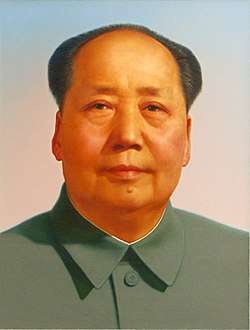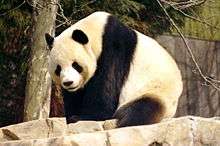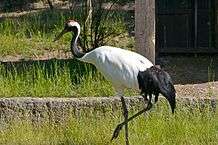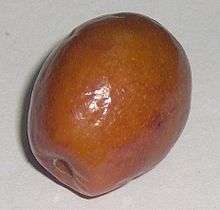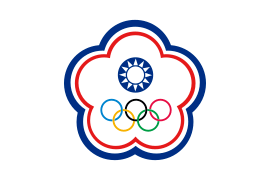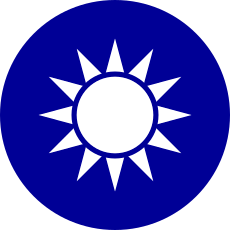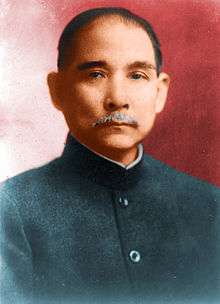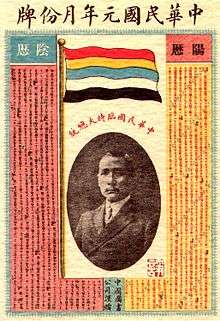National symbols of China
This is the current list of the national symbols of the People's Republic of China and of the Republic of China (Taiwan).
Symbols of the People’s Republic of China
| Symbol | Description | |
|---|---|---|
| National flag | National flag of the PRC (Wu Xing Hong Qi)
|
The national flag of the People's Republic of China was designed by Zeng Liansong. It has a red field charged with five golden stars in the canton. The color red represents the Communist Revolution, the four smaller stars represents the four social classes in Chinese society, and the largest star represents Chinese unity under the leadership of the Communist Party of China. One corner of each of the four smaller stars points towards the center of the bigger star, representing the principle that unity should go around the center. This flag is flown in the mainland, Hong Kong, and Macau. |
| National emblem | National Emblem (PRC)
|
The National Emblem of China includes Tianamen Gate, where Mao declared the foundation of People's Republic of China, in a red circle. Above the Gate are five stars; the largest represents the CPC, while the four smaller stars represent the four social classes. The emblem's outer border contains sheaves of wheat and rice, representing Chinese agricultural workers. At bottom center is a cog-wheel, representing Chinese industrial workers. The red ribbon represents the unification of the Chinese people. |
| National anthem | "March of the Volunteers" | The national anthem of China is the "March of the Volunteers". Its lyrics were composed by poet and playwright Tian Han and its music was composed by Nie Er. |
| Founder of the nation | Mao Zedong
|
Mao Zedong (1893–1976) established the PRC on October 1, 1949, which remains a national holiday. His portrait is displayed on the entrance of Tiananmen Square. |
| Qin Shi-huang, the Yellow Emperor | Qin Shi-huang (literally, "First Emperor of Qin") (259 BC - 210 BC) was the founder of the Qin dynasty and then, after the Qin conquered the other Warring States and unified all of China, the first emperor of a unified China.[1] He is widely considered to be the founder of China as a country. | |
| National currency | The renminbi is the official currency of the People's Republic of China. The yuan is its basic unit. The ISO code for renminbi is CHY. | |
| National animal | Giant panda
|
The national animal of China is the giant panda (Ailuropoda melanolueca), a bear native to south-central China. |
| Chinese dragon
|
The Chinese dragon is a legendary creature appearing in Chinese mythology and folklore. The dragon has many animal-like forms, including those resembling turtles and fish, but is usually depicted as a snake with four legs. | |
| National bird | Red-crowned crane
|
The red-crowned crane or Manchurian crane (Grus japonensis) is a large East Asian crane and among the rarest cranes in the world. It is found in Siberia (eastern Russia), northeastern China, and the Mongol Daguur Strictly Protected Area in northeastern Mongolia. |
| Golden pheasant (unofficial)
|
The golden pheasant (Chrysolophus pictus) is a game bird of the family Phasianidae. Although it is native to western China, feral populations have been established in the United Kingdom, Canada, the United States, Mexico, Colombia, Peru, Bolivia, Chile, Argentina, Uruguay, the Falkland Islands, Germany, Belgium, the Netherlands, France, Ireland, Australia and New Zealand. | |
| National fruit | Fuzzy kiwifruit
|
The fuzzy kiwifruit (Actinidia deliciosa) is the national fruit of China. It has fuzzy, dull brown skin and tangy, bright green flesh. |
| Jujube
|
The jujube (Ziziphus zizyphus) is the second national fruit of China. It is an oval drupe 1.5-3 centimeters deep; it resembles a date and has a single hard stone like an olive. | |
| National tree | Ginkgo
|
Ginkgo (Ginkgo biloba) is the only living species in the division Ginkgophyta, all others being extinct. Six ginkgo trees survived the atomic bombing of Hiroshima. |
Symbols of the Republic of China (Taiwan)
| Symbol | Description | |
|---|---|---|
| National flag | National flag of the ROC
|
The flag of the Republic of China was adopted in 1928 and is also known as "Blue Sky, White Sun, and a Wholly Red Earth". It was first used as the flag of Sun Yat-sen's government-in-exile in Tokyo. The ROC flag has not been used in the mainland, except in some museums and historical places, since the ROC government's relocation to Taiwan and the establishment of the People's Republic of China. Because the ROC flag's canton contains the flag of the Kuomintang Party of the Pan-Blue Coalition, supporters of the pro-independence Pan-Green Coalition do not use it. |
| The Chinese Taipei Olympic flag
|
Since the PRC's admission to the International Olympic Committee, the ROC has been barred from using its own flag in the Olympic Games. Instead, it is called Chinese Taipei and uses the Chinese Taipei flag. The flag is white with a blue-white-red bordered plum blossom, inside which the ROC's national emblem sits above the Olympic symbol. | |
| National emblem | Blue Sky with a White Sun
|
The National Emblem was adopted in 1947. Its design is derived from the Blue Sky with a White Sun emblem of the Kuomintang; the only difference between the ROC's national emblem and the KMT's is the blue margin outside the points of the star. As this also portrays KMT dominance in the ROC, many people want to change both the flag and the emblem to show a more democratic government. |
| National anthem | "National Anthem of Taiwan"
|
The national anthem was adopted informally in 1937 and formally in 1943. The anthem is also known as the San Min-chui (the Three Principles of the People) and was derived from Sun Yat-sen's speech at the inaugural ceremony of the Whampoa Military Academy. It discuses how the nation can achieve stability through the Three Principles.
The "National Flag Anthem" was adopted in 1937. The Flag Anthem is also called the "National Banner Song" and is sung when the national flag is raised. Because the ROC is barred from using both the ROC flag and anthem in the Olympics under PRC pressure, the Flag Anthem is used in place of the anthem. The "National Flag Anthem" was heard for the first time in the Olympics when the ROC (Chinese Taipei) won a gold medal in the 2004 Summer Olympics. |
| Founder of the nation | Sun Yat-sen
|
Sun Yat-sen (1866–1925) became the first president of the ROC in 1912. He proposed the Three Principles of the People and the Four-Stage Theory of the Republic of China, which served as the foundation of the Northern Expedition. He is highly honored in both the ROC and the PRC: in the ROC, presidents take oath in front of Dr. Sun's portrait, which is also displayed during National Day celebrations in both the ROC and the PRC. |
| Qin Shi-huang, the Yellow Emperor | Qin Shi-huang (literally, "First Emperor of Qin") (259 BC - 210 BC) was the founder of the Qin dynasty and then, after the Qin conquered the other Warring States and unified all of China, the first emperor of a unified China.[1] He is widely considered to be the founder of China as a country. | |
| Currency | ||
| National animal | Formosan rock macaque (unofficial) | |
| National bird | Mikado pheasant | |
| National tree | Camphor (unofficial) | |
| National flower | Plum blossom
|
The national flower was officially designated as the plum blossom by the Executive Yuan of the Republic of China on July 21, 1964.[2] The plum blossom, known as the meihua, is symbol for resilience and perseverance in the face of adversity, because plum blossoms often bloom most vibrantly even amidst the harsh winter snow.[3][4] The triple grouping of stamens represents Dr. Sun Yat-sen's Three Principles of the People, while the five petals symbolize the five branches of the government: Executive Yuan, Legislative Yuan, Judicial Yuan, Examination Yuan and Control Yuan.[2][4] |
| National year designation/calendar | Minguo calendar
|
The year 1912 (the first year of the Republic of China following the Xinhai Revolution the previous year) marks the beginning of the Republican (min-guo) calendar. The calendar follows the traditional pattern of the reign year of Chinese emperors, also called the Chinese era name. Once a new government is inaugurated in China, the year resets to 1, i.e. the first year of that era. The year 2018 is the 107th year of the Republican era, so it is min guo 107 nian. Some legislators have suggested abolishing this dating system. |
References
- 1 2 Duiker, William J. & al. World History: Volume I: To 1800, 5th ed., p. 78. Thomson Higher Education Publishing, 2006. ISBN 0-495-05053-9.
- 1 2 Government Information Office, Republic of China – National Flower Archived 2011-08-05 at the Wayback Machine.
- ↑ "The Three Friends of Winter: Paintings of Pine, Plum, and Bamboo from the Museum Collection". Taipei: National Palace Museum (國立故宮博物院). Retrieved 31 July 2011.
- 1 2 National Flag, Anthem and Flower
This article is issued from
Wikipedia.
The text is licensed under Creative Commons - Attribution - Sharealike.
Additional terms may apply for the media files.

.svg.png)
